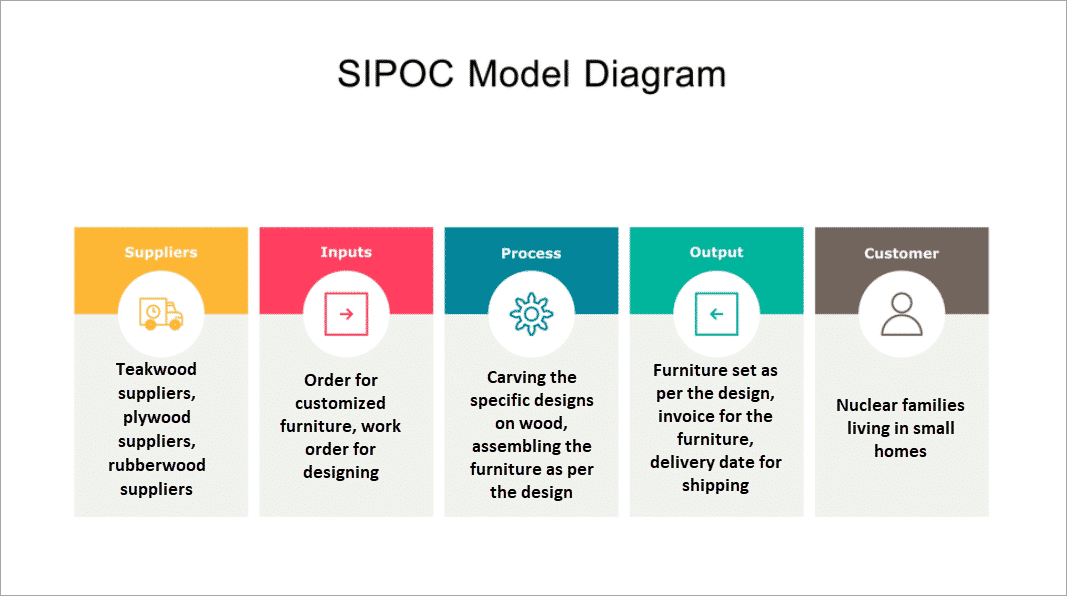SIPOC is a renowned acronym used in the Six Sigma methodology. It is one of the oldest and trusted tools in Six Sigma which was introduced in the second half of the 20th century. SIPOC is one of the top-level process mapping techniques that is applied before taking up Six Sigma projects. Various stakeholders benefit from such knowledge of the processes designed for a particular project. Moreover, the SIPOC diagram technique helps determine the relationship between various elements involved in satisfying customer needs.

Jump ahead to
What is the SIPOC Diagram?
SIPOC stands for Suppliers, Inputs, Process, Outputs, and Customers. The SIPOC diagram is a flowchart that represents the elements of SIPOC. Each process is matched against these elements for improvement before the project is undertaken. The SIPOC diagram helps in understanding each process from start to end prior to the implementation stage. Process management teams apply the SIPOC model to determine the suppliers of the process, requirements to the process, steps involved in the functioning of the process, expected results of the process, and the consumer who received the results.
Elements of SIPOC
Supplier: Every project needs to source its requirements from different entities. A supplier becomes the person who is providing these requirements to the organization. On identifying the suppliers, the first step of process mapping is complete.
Inputs: In this stage, the process management team gathers the inputs that can be sourced from the supplier. These inputs play a vital role in the whole process as they affect the outcomes of the Six Sigma project undertaken.
Process: This step describes the different stages involved in converting the inputs into outputs. Describing the steps helps the process team to understand the various activities that have to be performed.
Outputs: The outputs refer to the end results of the process. The outcomes can be in the form of products or services depending on the Six Sigma project undertaken. Moreover, the process team needs to ensure that the expected outcomes meet the customer’s needs.
Customer: The outcomes of a process delivered to the end-users or customers. It is a very crucial role for the process team to determine who the target customers of each process designed for the project.
Examples of SIPOC Diagram
Here is the SIPOC diagram for the furniture manufacturing facility
Suppliers: Teakwood suppliers, plywood suppliers, rubberwood suppliers
Inputs: Order for customized furniture, work order for designing
Process: Carving the specific designs on wood, assembling the furniture as per the design
Outputs: Furniture set as per the design, invoice for the furniture, delivery date for shipping
Customer: Nuclear families living in small homes
The process management teams uses above-mentioned SIPOC diagram for sharing it with stakeholders. The stakeholders then evaluate the process and further improvise if needed. The approved process is then applied by the team while taking up the project.
What are the benefits of the SIPOC diagram?
The SIPOC diagram is graphically represented making it easier to be understood. It offers a complete picture of each process. It helps in identifying the problems and taking measures to improve the process. In addition, the elements of SIPOC provide insights into how the process can be modified to meet customer requirements. Let us have a look at the major benefits of the SIPOC diagram.
Increased transparency
The SIPOC diagram provides a clear, concise high-level overview of a process. This clarity allows team members, stakeholders, or management, to easily understand the components of the process. It helps process management teams to be transparent with stakeholders. This further representing each process graphically ensures that all the stakeholders are on the same page.
Reduce waste
SIPOC offers an excellent overview of the process at a high level. This helps identify process regions where unnecessary steps. The SIPOC diagram facilitates the identification of redundant data or activities that may occur at various stages of the process. Further, finding this duplication enables more effective resource allocation.
Solve process-related problems
The SIPOC diagram is a useful tool for identifying potential issues, challenges, or gaps in the process that might affect its overall efficacy and efficiency. Professional uses it to resolve the problems arising out of a process. In addition, top management can take immediate action to improve a particular process, thereby enhancing the value of a project.
Improved communication
The SIPOC diagram provides a clear, visual representation of processes. As a result, team members and stakeholders are able to communicate more effectively. The SIPOC diagram aids in defining and identifying the different process stakeholders. In the course of communication and decision-making, this guarantees that all pertinent stakeholders recognized and taken into account.
Summary
The SIPOC Diagram is a powerful Six Sigma tool that provides a high-level view of any process by outlining its Suppliers, Inputs, Process, Outputs, and Customers. Individuals can refer to Lean Six Sigma Yellow Belt Interview Questions to understand SIPOC fundamentals. It helps teams identify process boundaries, key contributors, and value-adding steps. Those preparing for Lean Six Sigma Green Belt Interview Questions will find SIPOC crucial for process clarity and alignment. For advanced roles, Lean Six Sigma Black Belt Interview Questions cover SIPOC’s strategic use in end-to-end process improvement. Organizations use it across industries to achieve consistency, efficiency, and customer satisfaction.
Conclusion
Several organizations are applying the traditional tool of the SIPOC diagram for process improvement. Applying this Six Sigma tool requires individuals to be certified with Six Sigma certifications. So, organizations look for professionals who own the certification in Six Sigma to enhance their efficiency and profitability. There are different levels of Six Sigma certifications such as Six Sigma Yellow belt, Green belt, and Black belt. Individuals can take up either of these certifications while pursuing a career in quality management. Additionally, these certifications are internationally recognized, enabling professionals to land their dream jobs and earn higher salary packages.
FAQs on SIPOC Six Sigma Tool
1. What is a SIPOC diagram in Six Sigma?
SIPOC stands for Suppliers, Inputs, Process, Outputs, and Customers. It gives a high-level view of a process before detailed improvement begins.
2. Why is SIPOC important in quality management?
It helps teams visualize process flow, identify gaps, and ensure inputs align with customer needs.
3. When is SIPOC used in the Six Sigma process?
It’s mainly used during the Define phase of DMAIC to outline project boundaries and clarify processes.
4. How does SIPOC help in process improvement?
It simplifies identifying inefficiencies, reduces waste, and supports better decision-making.
5. What are the five elements of a SIPOC diagram?
The five elements are Suppliers, Inputs, Process, Outputs, and Customers—summarize the process flow from start to end.
6. How is SIPOC different from a process flowchart?
A SIPOC shows a broad overview, while a flowchart details each specific step in the process.
7. Can SIPOC be used outside manufacturing industries?
Yes, SIPOC applies to service, healthcare, finance, and IT sectors for improving process efficiency.
8. What are the benefits of creating a SIPOC diagram?
It improves team collaboration, defines clear process boundaries, and enhances communication.
9. Who is responsible for preparing a SIPOC diagram?
Process owners, project leaders, and Six Sigma professionals collaboratively design it to ensure accuracy.
10. What mistakes should be avoided in SIPOC analysis?
Avoid missing key inputs, overcomplicating steps, or failing to define customer expectations clearly.
11. How does SIPOC support customer satisfaction?
It ensures outputs directly meet customer requirements and expectations, improving service quality.
12. Can SIPOC diagrams be revised or updated?
Yes, they can be updated whenever process inputs, suppliers, or outputs undergo changes.
13. How does SIPOC contribute to continuous improvement?
It provides process clarity, aligns teams, and establishes a foundation for ongoing performance enhancement.



